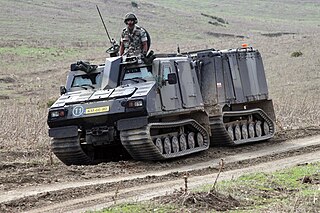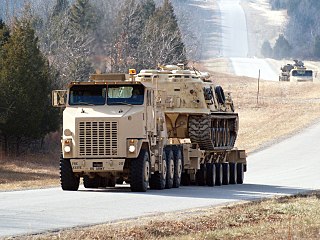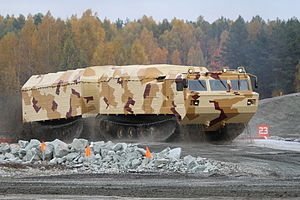
An amphibious vehicle, is a vehicle that is a means of transport viable on land as well as on or under water. Amphibious vehicles include amphibious bicycles, ATVs, cars, buses, trucks, railway vehicles, combat vehicles and hovercraft.

A half-track is a civilian or military vehicle with regular wheels at the front for steering and continuous tracks at the back to propel the vehicle and carry most of the load. The purpose of this combination is to produce a vehicle with the cross-country capabilities of a tank and the handling of a wheeled vehicle.

Oshkosh Corporation, formerly Oshkosh Truck, is an American industrial company that designs and builds specialty trucks, military vehicles, truck bodies, airport fire apparatus, and access equipment. The corporation also owns Pierce Manufacturing, a fire apparatus manufacturer in Appleton, Wisconsin, and JLG Industries, a leading manufacturer of lift equipment, including aerial lifts, boom lifts, scissor lifts, telehandlers and low-level access lifts.

Bandvagn 206 is a tracked articulated, all-terrain carrier developed by Hägglunds for the Swedish Army. It consists of two units, with all four tracks powered. It can carry up to 17 people, 6 in the front compartment, 11 in the rear. The trailer unit can be adapted for different uses.
Scammell Lorries Limited was a British manufacturer of trucks, particularly specialist and military off-highway vehicles, between 1921 and 1988. From 1955 Scammell was part of Leyland Motors.

Six-wheel drive is an all-wheel drive drivetrain configuration of three axles with at least two wheels on each axle capable of being driven simultaneously by the vehicle's engine. Unlike four-wheel drive drivetrains, the configuration is largely confined to heavy-duty off-road and military vehicles, such as all-terrain vehicles, armored vehicles, and prime movers.

Bandvagn 202 is an amphibious oversnow tracked articulated, all-terrain vehicle developed by Bolinder-Munktell, a subsidiary of Volvo, for the Swedish Army in the early 1960's.

The Nasu is a tracked articulated, all-terrain transport vehicle developed by Sisu Auto for the Finnish Army. It consists of two units, with all four tracks powered. It can carry up to 17 people, although the trailer unit can be adapted for different applications. There are two main versions, the NA-140 BT and the NA-110.

The BvS10 is a tracked articulated amphibious all-terrain armoured vehicle produced by BAE Systems Land Systems Hägglunds of Sweden. This vehicle, referred to as the All Terrain Vehicle (protected) - ATV(P) or Viking by the UK forces, was originally developed as a collaboration between industry - Hägglunds Vehicle AB - and the British Ministry of Defence (MoD) on behalf of the Royal Marines.

Raupenschlepper Ost was a fully tracked, lightweight vehicle used by the Wehrmacht in World War II. It was conceived in response to the poor performance of wheeled and half-tracked vehicles in the mud and snow during the Wehrmacht's first autumn and winter on the Soviet Front.

The Bronco All Terrain Tracked Carrier (ATTC) is a twin chassis multi-purpose tracked articulated vehicle jointly developed by ST Kinetics and the Defence Science and Technology Agency (DSTA) for the Singapore Army. The variant which was in service as a UOR with the British Armed Forces is known as the Warthog.

The Oshkosh M-ATV is a mine-resistant ambush protected (MRAP) vehicle developed by the Oshkosh Corporation for the MRAP All Terrain Vehicle (M-ATV) program. Intended to replace M1114 HMMWVs (Humvee), it is designed to provide the same levels of protection as the larger and heavier previous MRAPs, but with improved mobility.

Kharkovchanka, code name: Manufacture 404S, is a model of Antarctic off-road vehicle made circa 1957–1958 in the Soviet Union, designed and built by the Kharkov Transport Engineering Plant, and later manufactured in Kharkiv by the Malyshev Factory. Based on the AT-T tractor platform. In December 1959 two of them were delivered to Antarctica and reached the South Pole. The massive off-road snow vehicle had a total of a small galley, toilet, oven, and eight beds.

The EUROCEMENT group is the biggest supplier of cement, ready-mix concrete and aggregates in Russia. It has 16 cement plants across Russia, Ukraine and Uzbekistan as well as several concrete mix plants, concrete goods factories and aggregate-mining quarries.
The Group's annual production capacity is 40 MT of cement and 10 Mcm of concrete. Aggregate resources: carbonate rock explored reserves amount to 2.8 billion tonnes; granite-explored reserves amount to 1.8 billion tonnes.

PSA Bronto was a Russian company focused on the production of special vehicles and SUVs. It was established in 1993 and closed in 2015. While in operation, it was closely associated with AvtoVAZ. The Bronto badging is still used.

The Oshkosh M1070 is a U.S. Army tank transporter tractor unit. The primary purpose of this combination for the U.S. Army is the transport of the M1 Abrams tank.

SHERP is a Ukrainian UTV designed for rough and soggy terrain. The company is certified with international quality standards ISO 9001 and its headquartered in Kyiv (Ukraine). Its vehicles are sold all over the world through a wide dealership network including ARGO and STREIT Group.

A tracked articulated vehicle or articulated tracked vehicle, is a variation of a continuous track vehicle that consists of two cars, each with their own track, most commonly with an actuated linkage in between. This configuration allows an articulated tracked vehicle to turn by articulating the swivel joint in between the two vehicles, as opposed to using differential steering to move one track faster than the other.


















